Pulse Measurement from a Polluted Frequency Resolved Optical Gating Trace Based on Half-Trace Retrieval Algorithm
Abstract
1. Introduction
2. Methods
- At first, we denote the pulse guess before the n-th iteration as . The THG signal in the th iteration is represented aswhere is the index of the running step delay, and is the time delay step.
- THG signal is Fourier transformed, and its modulus is replaced by the square root of the measured spectrum at the j-th delaywhere denotes the Fourier transform function.
- The updated THG signal can be calculated by the inverse Fourier transform aswhere denotes the inverse Fourier transform function.
- The probe pulse and the gated pulse can be updated aswhere the update coefficient is set as that in [21]
- The complete pulse distribution can be reconstructed by connecting the front edge of the pulse and the rear edge of the pulse together as (Both of the centroid of pulses and are moved to , and the centroid of the intensity distribution of pulse and is calculated by , where represents the temporal intensity distribution of the pulse.
- is chosen as the next initial guess, and the procedures from steps one to five are repeated in the next delay index. The FROG error between the calculated and measured traces is calculated until all of the delay indices are updated once an iteration, as follows:where N denotes the number of sampling points. The iterations continue until the error is smaller than the signal-to-noise ratio (SNR) or until a fixed number of iterations is completed. At last, the procedures from steps one to six are repeated for the other ten initial guesses of pulses , and the results with the smallest FROG error were chosen for the final solution.
3. Results and Discussion
3.1. Numerical Simulation
3.2. Experiments
4. Conclusions
Author Contributions
Funding
Institutional Review Board Statement
Informed Consent Statement
Data Availability Statement
Conflicts of Interest
References
- Sapra, N.V.; Yang, K.Y.; Vercruysse, D.; Leedle, K.J.; Black, D.S.; England, R.J.; Su, L.; Trivedi, R.; Miao, Y.; Solgaard, O.; et al. On-chip integrated laser-driven particle accelerator. Science 2020, 367, 79. [Google Scholar] [CrossRef] [PubMed]
- Betti, R.; Hurricane, O.A. Inertial-confinement fusion with lasers. Nat. Phys. 2016, 12, 435–448. [Google Scholar] [CrossRef]
- Craxton, R.S.; Anderson, K.S.; Boehly, T.R.; Goncharov, V.N.; Harding, D.R.; Knauer, J.P.; McCrory, R.L.; McKenty, P.W.; Meyerhofer, D.D.; Myatt, J.F.; et al. Direct-drive inertial confinement fusion: A review. Phys. Plasmas 2015, 22. [Google Scholar] [CrossRef]
- Glenzer, S.H.; Redmer, R. X-ray Thomson scattering in high energy density plasmas. Rev. Mod. Phys. 2009, 81, 1625–1663. [Google Scholar] [CrossRef]
- Heebner, J.E.; Acree, R.L.; Alessi, D.A.; Barnes, A.I.; Bowers, M.W.; Browning, D.F.; Budge, T.S.; Burns, S.; Chang, L.S.; Christensen, K.S.; et al. Injection laser system for Advanced Radiographic Capability using chirped pulse amplification on the National Ignition Facility. Appl. Opt. 2019, 58, 8501–8510. [Google Scholar] [CrossRef] [PubMed]
- Meaney, K.D.; Kerr, S.; Williams, G.J.; Geppert-Kleinrath, H.; Kim, Y.; Herrmann, H.W.; Kalantar, D.H.; Mackinnon, A.; Bowers, M.; Pelz, L.; et al. Multi-pulse time resolved gamma ray spectroscopy of the advanced radiographic capability using gas Cherenkov diagnostics. Phys. Plasmas 2021, 28, 033102. [Google Scholar] [CrossRef]
- Stan, C.V.; Saunders, A.M.; Hill, M.P.; Lockard, T.; Mackay, K.; Ali, S.J.M.; Rudd, R.E.; McNaney, J.; Eggert, J.; Park, H.S. Radiographic areal density measurements on the OMEGA EP laser system. Rev. Sci. Instrum. 2021, 92, 053901. [Google Scholar] [CrossRef]
- Valdivia, M.P.; Stutman, D.; Stoeckl, C.; Mileham, C.; Zou, J.; Muller, S.; Kaiser, K.; Sorce, C.; Keiter, P.A.; Fein, J.R.; et al. Implementation of a Talbot-Lau x-ray deflectometer diagnostic platform for the OMEGA EP laser. Rev. Sci. Instrum. 2020, 91, 023511. [Google Scholar] [CrossRef]
- Hopps, N.; Danson, C.; Duffield, S.; Egan, D.; Elsmere, S.; Girling, M.; Harvey, E.; Hillier, D.; Norman, M.; Parker, S.; et al. Overview of laser systems for the Orion facility at the AWE. Appl. Opt. 2013, 52, 3597–3607. [Google Scholar] [CrossRef]
- Danson, C.N.; Brummitt, P.A.; Clarke, R.J.; Collier, J.L.; Fell, B.; Frackiewicz, A.; Hancock, S.; Hawkes, S.; Hernandez-Gomez, C.; Holligan, P.; et al. Vulcan Petawatt—An ultra-high-intensity interaction facility. Nucl. Fusion 2004, 44, S239–S246. [Google Scholar] [CrossRef]
- Zhu, J. Review of special issue on high power facility and technical development at the NLHPLP. High Power Laser Sci. Eng. 2019, 7, e12. [Google Scholar] [CrossRef]
- Kane, D.J.; Trebino, R. Characterization of Arbitrary Femtosecond Pulses Using Frequency-Resolved Optical Gating. IEEE J. Quantum Electron. 1993, 29, 571–579. [Google Scholar] [CrossRef]
- Kane, D.J. Real-time measurement of ultrashort laser pulses using principal component generalized projections. IEEE J. Sel. Top. Quantum Electron. 1998, 4, 278–284. [Google Scholar] [CrossRef]
- Jafari, R.; Jones, T.; Trebino, R. 100frequency-resolved optical gating. Opt. Express 2019, 27, 2112–2124. [Google Scholar] [CrossRef]
- Jafari, R.; Khosravi, S.D.; Trebino, R. Reliable determination of pulse-shape instability in trains of ultrashort laser pulses using frequency-resolved optical gating. Sci. Rep. 2022, 12, 21006. [Google Scholar] [CrossRef]
- Khosravi, S.D.; Jafari, R.; Schittenhelm, M.; Suresh, S.; Gibson, G.N.; Trebino, R. Characterization of two-color ultrashort laser pulses using polarization-gating and transient-grating frequency-resolved optical gating. J. Opt. Soc. Am. B-Opt. Phys. 2022, 39, 683–693. [Google Scholar] [CrossRef]
- Spangenberg, D.; Rohwer, E.; Bruegmann, M.H.; Feurer, T. Ptychographic ultrafast pulse reconstruction. Opt. Lett. 2015, 40, 1002–1005. [Google Scholar] [CrossRef]
- Sidorenko, P.; Lahav, O.; Avnat, Z.; Cohen, O. Ptychographic reconstruction algorithm for frequency-resolved optical gating: Super-resolution and supreme robustness. Optica 2016, 3, 1320. [Google Scholar] [CrossRef]
- Kane, D.J. Comparison of the Ptychographic Inversion Engine to Principal Components Generalized Projections. IEEE J. Sel. Top. Quantum Electron. 2019, 25, 1–8. [Google Scholar] [CrossRef]
- Chen, H.; Hermann, M.R.; Kalantar, D.H.; Martinez, D.A.; Di Nicola, P.; Tommasini, R.; Landen, O.L.; Alessi, D.; Bowers, M.; Browning, D.; et al. High-energy (> 70 keV) x-ray conversion efficiency measurement on the ARC laser at the National Ignition Facility. Phys. Plasmas 2017, 24, 033112. [Google Scholar] [CrossRef]
- Pan, L.; Ouyang, X.; Zhang, X.; Zhu, P.; Liu, C.; Li, Z.; Zhu, B.; Zhu, J.; Zhu, J. Picosecond frequency-resolved optical gating based on a modified ptychographic-based algorithm for use in a petawatt laser. Opt. Eng. 2020, 59, 054103. [Google Scholar] [CrossRef]
- Thibault, P.; Dierolf, M.; Bunk, O.; Menzel, A.; Pfeiffer, F. Probe retrieval in ptychographic coherent diffractive imaging. Ultramicroscopy 2009, 109, 338–343. [Google Scholar] [CrossRef]


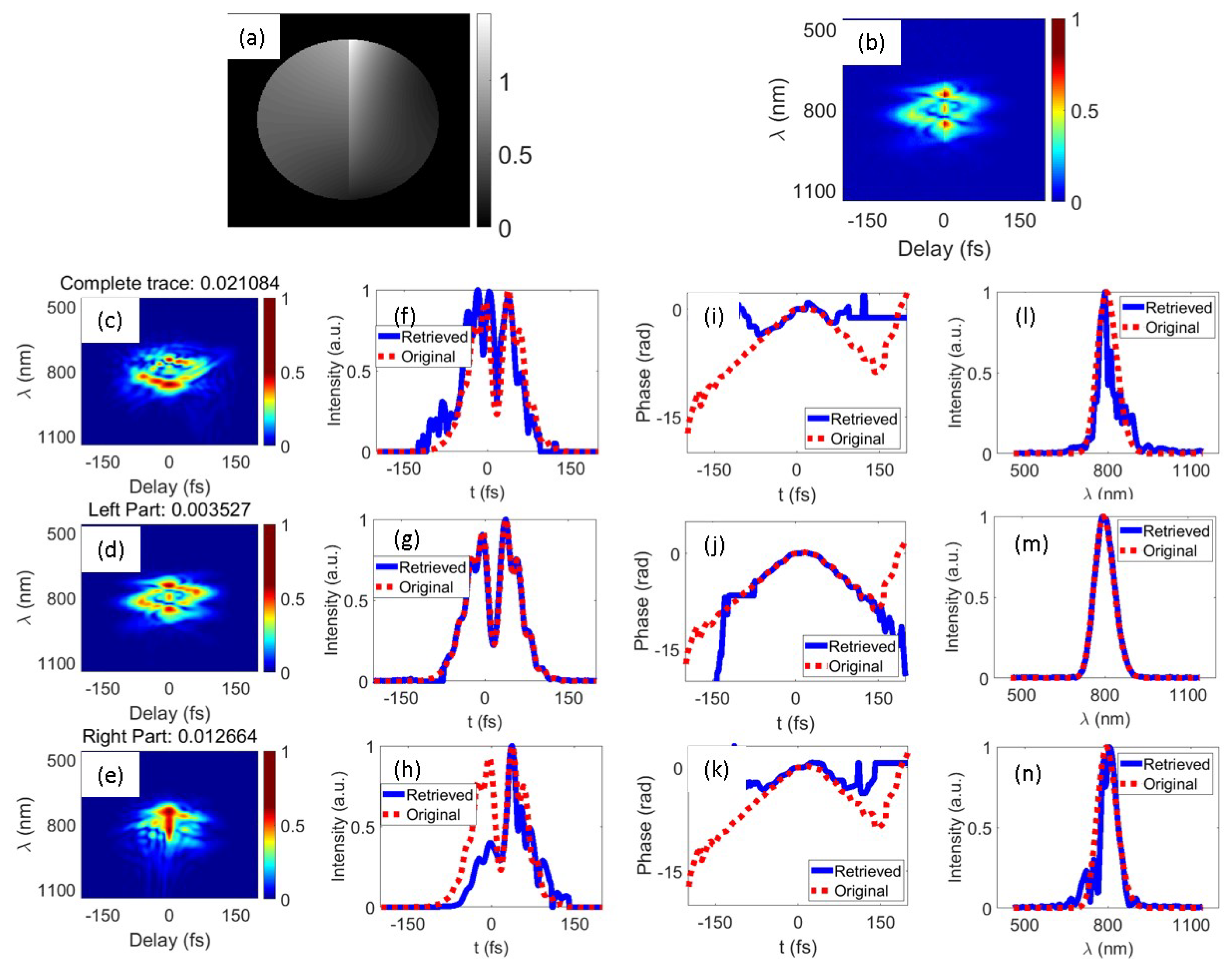
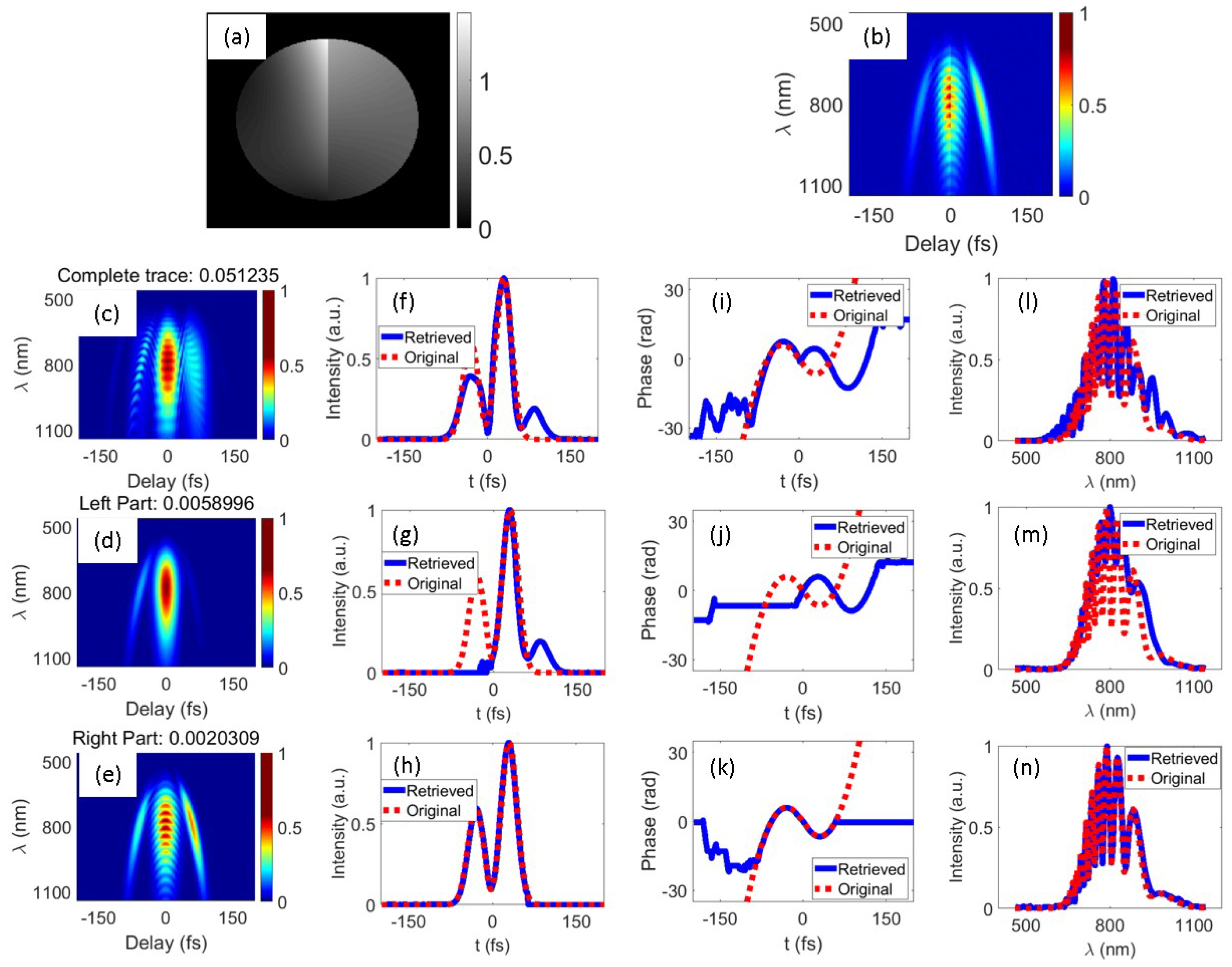
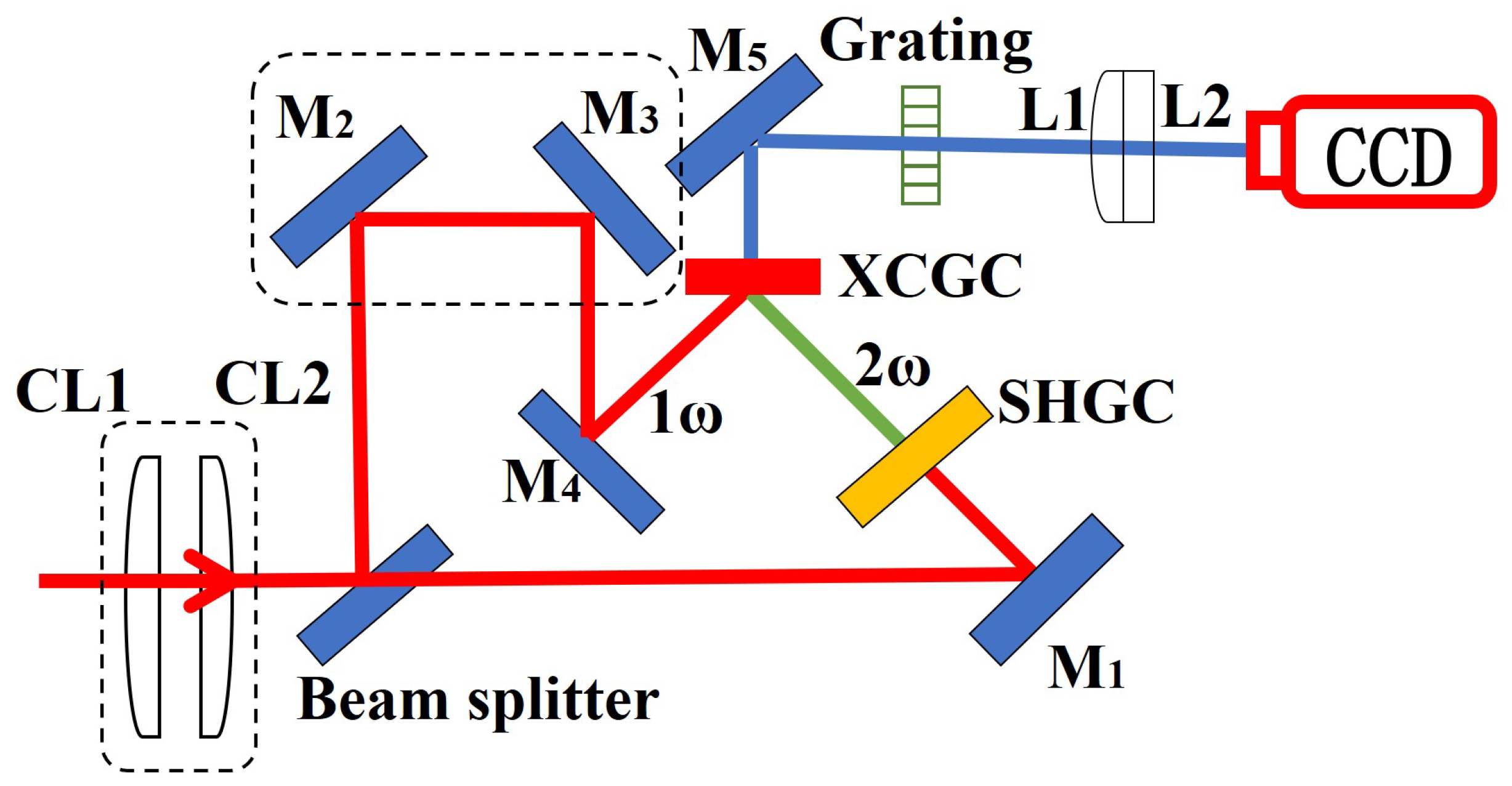
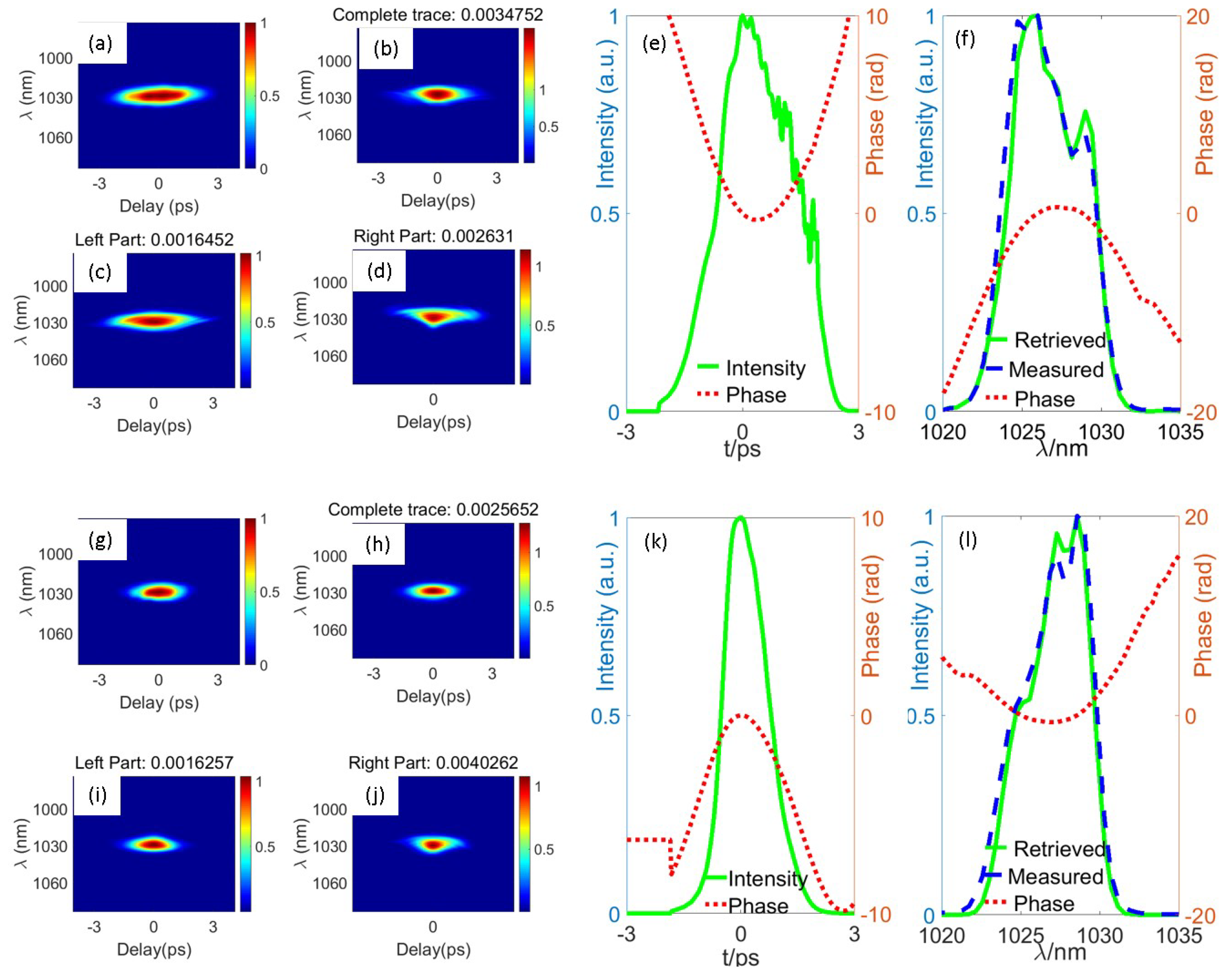

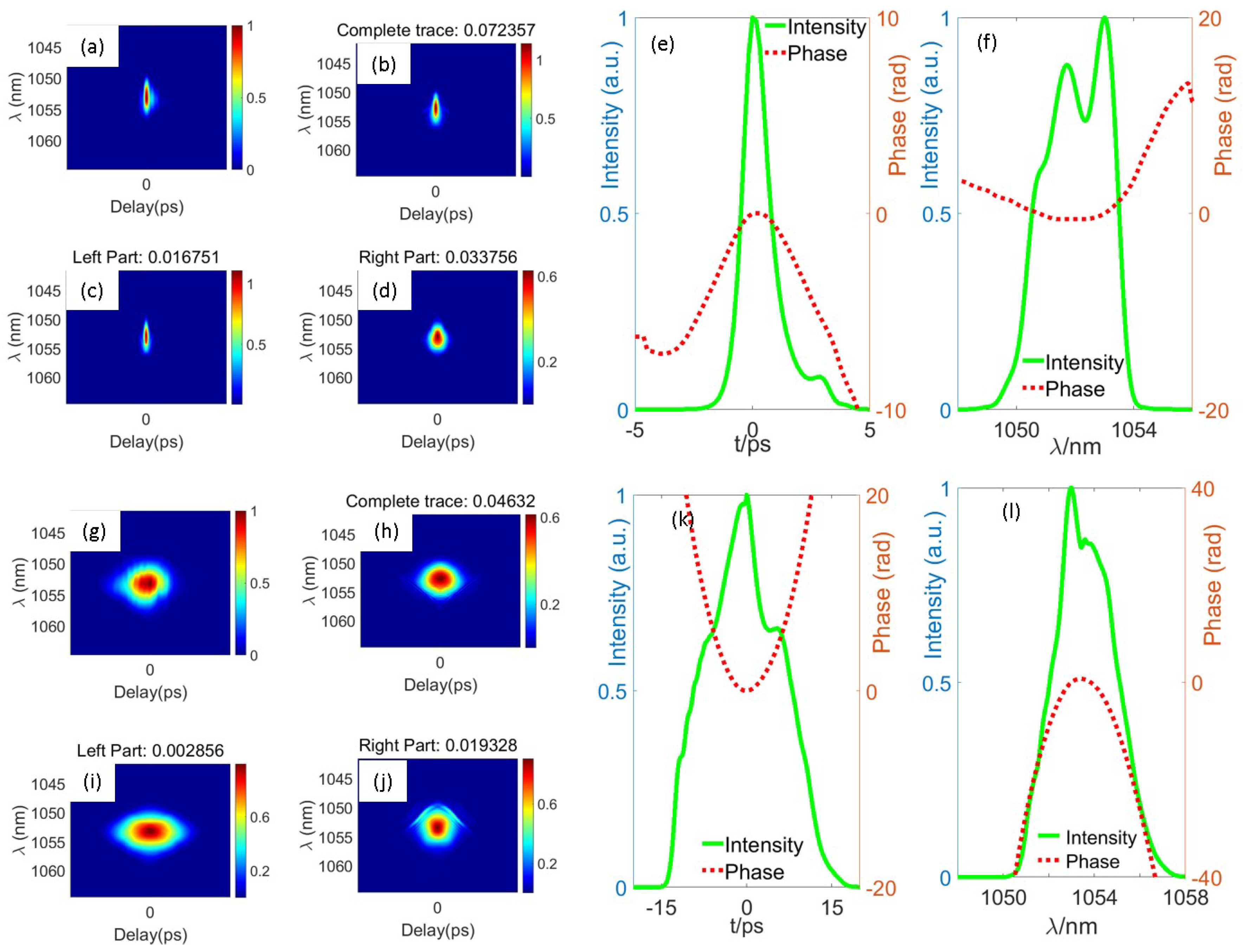
Disclaimer/Publisher’s Note: The statements, opinions and data contained in all publications are solely those of the individual author(s) and contributor(s) and not of MDPI and/or the editor(s). MDPI and/or the editor(s) disclaim responsibility for any injury to people or property resulting from any ideas, methods, instructions or products referred to in the content. |
© 2023 by the authors. Licensee MDPI, Basel, Switzerland. This article is an open access article distributed under the terms and conditions of the Creative Commons Attribution (CC BY) license (https://creativecommons.org/licenses/by/4.0/).
Share and Cite
Pan, L.; Ouyang, X.; Zhang, X.; Liu, C.; Zhu, J. Pulse Measurement from a Polluted Frequency Resolved Optical Gating Trace Based on Half-Trace Retrieval Algorithm. Photonics 2023, 10, 255. https://doi.org/10.3390/photonics10030255
Pan L, Ouyang X, Zhang X, Liu C, Zhu J. Pulse Measurement from a Polluted Frequency Resolved Optical Gating Trace Based on Half-Trace Retrieval Algorithm. Photonics. 2023; 10(3):255. https://doi.org/10.3390/photonics10030255
Chicago/Turabian StylePan, Liangze, Xiaoping Ouyang, Xuejie Zhang, Cheng Liu, and Jianqiang Zhu. 2023. "Pulse Measurement from a Polluted Frequency Resolved Optical Gating Trace Based on Half-Trace Retrieval Algorithm" Photonics 10, no. 3: 255. https://doi.org/10.3390/photonics10030255
APA StylePan, L., Ouyang, X., Zhang, X., Liu, C., & Zhu, J. (2023). Pulse Measurement from a Polluted Frequency Resolved Optical Gating Trace Based on Half-Trace Retrieval Algorithm. Photonics, 10(3), 255. https://doi.org/10.3390/photonics10030255




